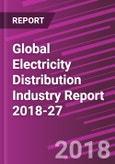1. GLOBAL ELECTRICITY DISTRIBUTION INDUSTRY1.1. Introduction1.2. Executive summary1.3. Growth in distribution system by region, 2008-17
1.3.1. Consumption/sales mix and growth
1.3.2. Growth in number of customers
1.3.3. Size and growth in distribution network
1.3.3.1. Line length
1.3.3.2. Transformer capacity
1.4. Trends in operational performance by region, 2008-17
1.4.1. Distribution network losses
1.4.2. SAIFI and SAIDI Indices
1.5. Trends in financial performance by region, 2008-17
1.5.1. Trends in revenues from electricity distribution
1.5.2. Trends in capex/investment in distribution network
1.6. Forecast for growth for the distribution industry, 2018-27
1.6.1. Expected growth in consumption/sales
1.6.2. Expected growth in network size
1.6.2.1. Line length
1.6.2.2. Transformer capacity
1.6.3. Expected trends in capex/investment
1.7. Market and regulatory framework by region
1.7.1. Ownership structure
1.7.2. Tariff setting mechanism
1.8. Trends in adoption of smart grid technologies in view of:
- Renewable energy
- Distributed energy resources
- Energy storage
- Electric vehicles
1.9. Trends in metering
1.9.1. Under-metered and unmetered markets
1.9.2. Smart metering
1.9.3. Prepaid metering
1.11. Outlook and opportunities
1.11.1. Expected opportunities for investors
1.11.2. Opportunities for equipment suppliers
2.1. North America
2.1.1. Regional analysis
2.1.2. Canada
2.1.3. USA
2.2. Latin America
2.2.1. Regional analysis
2.2.2. Argentina
2.2.3. Bolivia
2.2.4. Brazil
2.2.5. Chile
2.2.6. Colombia
2.2.7. Costa Rica
2.2.8. Dominican Republic
2.2.9. Ecuador
2.2.10. Guatemala
2.2.11. Honduras
2.2.12. Mexico
2.2.13. Nicaragua
2.2.14. Panama
2.2.15. Peru
2.2.16. Uruguay
2.3. Asia
2.3.1. Regional analysis
2.3.2. Australia
2.3.3. Bangladesh
2.3.4. Cambodia
2.3.5. China
2.3.6. India
2.3.7. Indonesia
2.3.8. Japan
2.3.9. Kazakhstan
2.3.10. Malaysia
2.3.11. Myanmar
2.3.12. Nepal
2.3.13. Pakistan
2.3.14. Philippines
2.3.15. Sri Lanka
2.3.16. Thailand
2.3.17. Vietnam
2.4. Europe
2.4.1. Regional analysis
2.4.2. Austria
2.4.3. Belgium
2.4.4. Croatia
2.4.5. Czech Republic
2.4.6. Denmark
2.4.7. Estonia
2.4.8. Finland
2.4.9. France
2.4.10. Germany
2.4.11. Greece
2.4.12. Ireland
2.4.13. Italy
2.4.14. Latvia
2.4.15. Lithuania
2.4.16. Netherlands
2.4.17. Norway
2.4.18. Poland
2.4.19. Portugal
2.4.20. Romania
2.4.21. Russia
2.4.22. Spain
2.4.23. Sweden
2.4.24. Turkey
2.4.25. United Kingdom
2.4.26. Ukraine
2.5. Middle East
2.5.1. Regional analysis
2.5.2. Oman
2.5.3. Qatar
2.5.4. Saudi Arabia
2.5.5. United Arab Emirates
2.6. Africa
2.6.1. Regional analysis
2.6.2. Algeria
2.6.3. Cameroon
2.6.4. Egypt
2.6.5. Ethiopia
2.6.6. Ghana
2.6.7. Ivory Coast
2.6.8. Kenya
2.6.9. Morocco
2.6.10. Nigeria
2.6.11. South Africa
2.6.12. Sudan
2.6.13. Tanzania
2.6.14. Uganda
3.1. Sources and methodology
3.2. List of abbreviations
Each regional analysis will have:
1. Regulatory framework and tariff setting mechanism analysis
2. Consumer mix and growth
3. Consumption/sales mix and growth, 2008-17
4. Growth in distribution network, 2008-17
5. Growth in capex/investment, 2008-17
6. Expected growth in consumption/sales, 2018-27
7. Expected growth in network, 2018-27
8. Expected growth in capex/investment, 2018-27
9. Smart grid and metering trends and plans
10. Outlook and opportunities
Each country profile will have information and analysis on:
1. Sector overview
2. Institutional and regulatory structure
2.1. Key institutions and players
2.2. DSO licensing requirements
2.3. Distribution tariff setting mechanism
2.4. Key recent policy and regulatory developments
3. Sector size and past growth (2008-17)
3.1. Installed capacity
3.2. Electricity production
3.3. Number of consumers
3.3.1. Growth in number of consumers
3.3.2. Consumers by category
3.4. Electricity consumption or sales
3.4.1. Growth in total consumption/sales
3.4.2. Consumption/sales mix by consumer category
4. Size and growth in distribution network (2008-17)
4.1. Growth in line length
4.2. Growth in transformer capacity
5. Trends in operational performance (2008-17)
5.1. Distribution losses
5.2. SAIFI/SAIDI Indices
6. Trends in financial performance(2008-17)
6.1. Trends in revenues from electricity distribution
6.2. Trends in capex/investment in distribution network
7. Smart grid and metering efforts, initiatives, roll-out and targets
8. Forecast and projections (2018-27)
8.1. Expected growth in consumption
8.2. Network plans and targets
8.3. Expected growth in network
8.4. Expected capex/investment trends
9. Outlook and opportunities in the sector
10. Inter-DSO comparison (for up to 5 key DSOs)
10.1. Ownership
10.2. Area of operations
10.3. Size and character of operations
10.3.1. Size of distribution network (line length and capacity)
10.3.2. Number of customers
10.3.3. Customer mix
10.3.4. Energy delivered or carried/sold/distributed
10.3.5. Number of meters/smart meters installed
10.4. Operational performance
10.4.1. Network losses
10.4.2. SAIFI
10.4.3. SAIDI
10.5. Financial performance
10.5.1. Revenues
10.5.2. Profit/Loss
10.5.3. EBITDA
10.5.4. Debt-Equity ratio
10.5.5. Return on equity
10.5.6. Capex
10.6. Future plans
10.6.1. Network expansion
10.6.2. Smart grid
10.6.3. Metering








